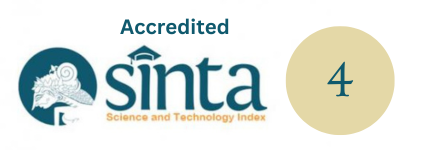Musical Composition "Sedimentasi" | Komposisi Karawitan "Sedimentasi"
DOI:
https://doi.org/10.59997/jurnalsenikarawitan.v1i1.148Keywords:
Sedimentasi, Contemporer, Gong Kebyar, Joged BumbungAbstract
Sedimentation is the process of formation of sedimentary rock originating from the deposition of chemical solutions and the deposition of certain organisms activities, sedimentary rocks are also formed from the deposition of several abiotic components in the environment such as soil and sand. Sedimentation undergoes three processes, those processes are actualized into a structure consisting of three parts in the sedimentation karawitan musical artwork. Sedimentation karawitan musical artwork used barungan gamelan Gong Kebyar as the media to express it, including Pemade pengumbang, Pemade pengisep, Kantil pengumbang, and some of the Joged Bumbung gamelan, namely Rindik pengumbang, Rindik pengisep, and Kantil pengumbang made from bamboo. This artwork refers to musical elements such as melody, rhythm, tempo, dynamics, and harmony. Sedimentation karawitan musical artworks are presented in a concert, supported by 3 musicians including the composer, performed at Siwer Manis studio, located in Banjar Samu, Singapadu Kaler, Sukawati, Gianyar. The Penabuh (musicians) or players are divided according to their expertise, the first musician played the Pemade Pengumbang Instrument and the Pengumbang Rindik Instrument alternately, the second musician played the pemade pengisep and rindik pengisep instruments, and the third musician played the kantil pengumbang and bamboo kantil pengumbang instruments.
Downloads
References
A.A.M.Djelantik. 1999. Estetika: Sebuah Pengantar. Bandung: Masyarakat Seni Pertunjukan Indonesia (MSPI).
Arya Sugiartha. 2012. Kreatifitas Musik Bali Garapan Baru Perspektif Cultural Studies. Denpasar: UPT Penerbitan ISI Denpasar.
Bandem, I Made. 2013. Gamelan Bali Diatas Panggung Sejarah. Denpasar: BP. STIKOM BALI.
Garwa, I Ketut. 2009. Buku Ajar Komposisi Karawitan IV. Denpasar: Institut Seni Indonesia.
Hardjana, Suka. 2011. Corat-Coret Musik Kontemporer Dulu Dan Kini. Jakarta: Ford Foundation.
Hawkins, Alma M. 2003. Mencipta Lewat Tari. Terj. Y. Sumandiyo Hadi. Yogyakarta: Manthili.
Kariasa, I Nyoman. 2012. “Deskripsi Karya Seni "Gamelan Tajen” Fenomena Sosial Sebagai Sumber Inspirasi Penciptaan.” Institut Seni Indonesia (ISI) Surakarta.
Levine, Victoria Lindsay. 2001. “Joged Bumbung: Rindik Music.” ProQuest 45(3): 43.
Santosa, Hendra; Saptono. 2016. “Gamelan Sistem Sepuluh Nada Dalam Satu Gembyang Untuk Olah Kreativitas Karawitan Bali.” Pantun 1(2): 85–96. https://jurnal.isbi.ac.id/index.php/pantun/article/view/747.
Stepputat, Kendra. 2006. “Nice ‘n’ Easy: The Balinese Gamelan Rindik: Its Music, Musicians, and Value as Tourist Art.” Asian Music 37(2): 84–121.
Surjono, Sugeng Sapto. 2017. Sedimentologi. Yogyakarta: Gadjah Mada University Press.








